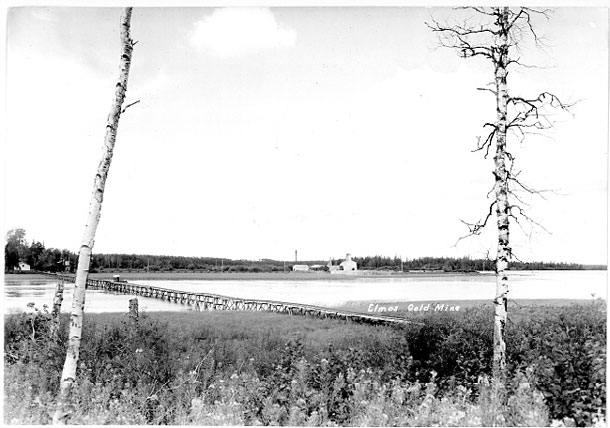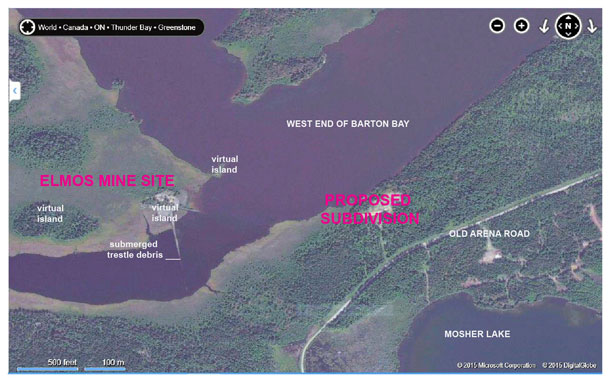
GREENSTONE -LIVING – Elmos Gold Mines started life in 1938 on a tiny island in Barton Bay, Kenogamisis Lake, within the boundaries of present-day Geraldton. In 1942, the mine was mothballed.
Talmora Longlac Gold Mines, Limited, became a corporation in November 1944, embracing 9 claims of the former Elmos mine (acquired from Tombill Gold Mines) and 4 adjoining claims east of the shaft from Mosher Long Lac Gold Mines, Limited. Compare the size of the property with the Elmos mine in the beginning: 57 claims.
Mining operations commenced on June 6, 1947. The underground workings were dewatered (mines left unattended fill up with water. In 1942, during operations, pumps were handling 180 gallons a minute). Miners continued drifting (tunneling on a horizontal plane outward from the shaft), crosscutting (making side tunnels), and raising (creating vertical tunnels or shafts, often at an angle). Miners hoisted 2,936 tons of ore for processing in the reconditioned mill, still on site. The mine employed an average of 22 men. W.S. Hargraft still acted as manager.
Operations continued in 1948 . Miners hoisted another 2,687 tons of ore and milled them. An average of 27 men were working. On April 30, the mine shut down. For good. In 1949, Mosher Long Lac Gold Mines took back its 4 claims, and Tombill Gold Mines acquired all remaining assets.
“Gee, it must be nice to own a gold mine, or even a piece of it.” That’s what most people think. The history of the Beardmore-Geraldton gold field must give the thinking person pause. Many mines had very short lives. In many cases, investors threw their money into bottomless pits and never saw a return. Recent history bears this out. Since the revival of gold exploration in this region in 2007, hundreds of millions of dollars have been expended and still no new mine.
The old Elmos mine had a very short life: 21 months in 1938-39 (with no gold production), 5 months in 1942, and 11 months in 1947-48. What did mining operations cost? We do have figures for the 11 months in 1938: $38,525.52 for plant and equipment, and $98,120.04 on underground operations. Remember that operations in 1938-39 produced no gold.
What was the return on investment? The old Elmos began producing in 1942: 1,017 oz. in gold and 36.5 oz. in silver, for a total value of $39,168.
In 1947, there is no record of production, and we can safely assume that production of precious metals occurred in 1948. In 1948, the mine produced 398 oz. in gold and 30 oz. in silver (from a total of 5,623 tons of ore), valued at approximately $14,000. (Gold price was fixed at $35 an ounce.)
So, total production at the old Emos mine was 1,415 ounces which, along with a few ounces of silver, was valued at approximately $53,168. Compare that figure to the cost of plant and operations in 1938 alone.
Just a sidebar: In 1947, the Maylac mine (the old Hutchison Lake mine) sent some of its ore to the Talmora Longlac for milling, and the rest to the Hard Rock mine.
Another sidebar, from the B.Sc. thesis referenced earlier: “Amalgamation resulted in the recovery of only 40.232 ounces of gold, but 150.205 tons of flotation concentrate were shipped to the Noranda smelter and 358.222 ounces of gold recovered, making a total of 398.45 ounces.”
To put the production of the Talmora Longlac in perspective, in 5 years of production, the Tombill mine produced 68,739 ounces in gold and 8,595 ounces in silver. The Little Long Lac, in 22 years, produced 605,449 ounces of gold and 52,750 ounces of silver.
And the MacLeod-Cockshutt produced 1,366,404 ounces of gold and 90,864 ounces of silver in 28 years.
Yes, as a gold mine, the old Elmos was a disappointment — a major-league flop. However, today the Elmos is a priceless historical asset to the Greenstone region. Besides being a cautionary tale to investors and mine developers for all time, it is a unique site. How many people in Canada — hey, in all the world — can point to a tiny little mine established on a tiny little island which had to be enlarged with waste rock to support itself? Okay, there is the old Silver Islet mine off the Sleeping Giant peninsula in Lake Superior. That mine is still world famous . . . even though that tiny little island has all but washed away. But how many tiny little mines on tiny little islands in all the world were connected to the mainland by a flimsy little bridge that you couldn’t even drive a horse and wagon across, let alone a truck?
Yeah, you got it. And we got it . . . here in Greenstone. And the consultants and the authorities today think that the old Elmos has no historical value. They actually say that, in print.
Go on, now . . . Think of a reason why the old Elmos mine cannot became a major attraction in Greenstone . . . in Canada . . . in all the world . . .
Okay, we’ll settle for two out of three.
The conclusion of this Elmos mine saga will appear on the Facebook group Greenstone History.

[E.J. Lavoie is a writer and regional historian who lives in a big cabin on a big lake in Greenstone.]







